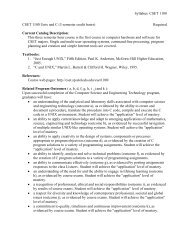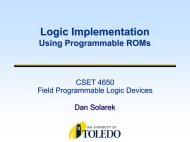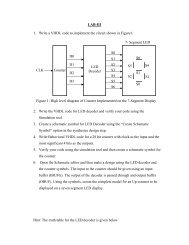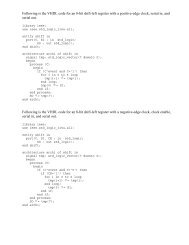Programmable Logic and Application Specific Integrated Circuits
Programmable Logic and Application Specific Integrated Circuits
Programmable Logic and Application Specific Integrated Circuits
Create successful ePaper yourself
Turn your PDF publications into a flip-book with our unique Google optimized e-Paper software.
in Figure 5, present day CMOS has the advantage below 100-150mhz. However, as system clock<br />
rates exceed 150-200mhz GaAs currently has a clear advantage in terms of its speed-power<br />
product, especially for low-voltage applications. 5 Note that this crossover point moves as process<br />
technology scales; <strong>and</strong> the CMOS crossover point can be expected to move to higher clock<br />
frequencies for deep sub-micron CMOS processing.<br />
Power<br />
Consumption<br />
Clock Frequency<br />
12<br />
100 -<br />
150 MHZ<br />
CMOS<br />
GaAs<br />
Figure 5. CMOS <strong>and</strong> GaAs Power Consumption vs. Frequency<br />
III. Field <strong>Programmable</strong> <strong>Logic</strong><br />
<strong>Programmable</strong> logic devices have over two decades of history of use in electronic systems.<br />
Their origins coincided with the development of <strong>Programmable</strong> Read-Only Memorie (PROM) <strong>and</strong><br />
Erasable PROM (EPROM) technologies around the same time as the microprocessor. However,<br />
until recently their development <strong>and</strong> use has been overshadowed by the headlong advances of<br />
microprocessor technology. Their main historical role was in replacing the multitude of Small<br />
Scale Integration (SSI) <strong>and</strong> Medium Scale Integration (MSI) “glue logic” parts which were needed<br />
in microprocessor based systems. It is only within the past seven years that programmable logic<br />
devices have become dense enough <strong>and</strong> fast enough to play more major roles in digital systems
















